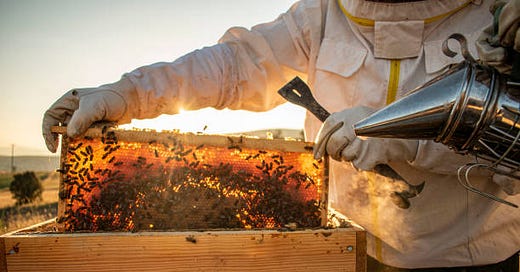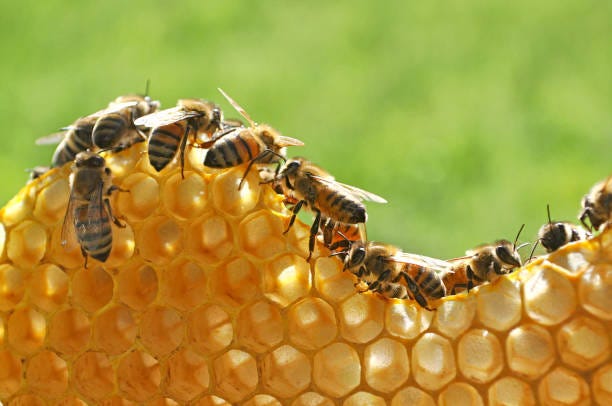“If bees only gathered nectar from perfect flowers, they wouldn’t be able to make even a single drop of honey." – Matshona Dhliwayo
Origin of Beekeeping
Honey can be found on dinner tables and in kitchens, often used for medicinal purposes. If bees are spotted in the garden or the small green corner of the balcony, it means the flowers are blooming. Bees are also a sign of the coming of spring.
Beekeeping is the art and skill of maintaining bee colonies to produce hive products (honey, beeswax) and pollination services. Beekeeping is also known as Apiculture, derived from the Latin word apiscultura, where Apis means bees and cultura denotes cultivation through education.
There is archaeological evidence that about 4,000 years ago, the Egyptians kept clay pots and used honey, wax, and propolis. In ancient Greece and Rome, apiculture was a common practice. The philosopher Aristotle, in his book Historia Animalum, discussed honeybees' floral fidelity, division of labour within the colony, and winter feeding. Greek athletes used honey as an energy booster. The Roman poet Virgil explained the proper way to install apiaries. Scholars suggest that commercial beekeeping started during the second half of the 19th century. In 1851, L. L. Langstroth discovered the concept of "bee space," a 3/8-inch gap that bees maintain between two adjacent combs as their passage for free movement. Based on this concept, the modern "Langstroth bee hive" with movable parallel frames/combs was developed. Langstroth is known as the Father of Modern Beekeeping.
Beekeeping in India
Types of Honeybees in India
Rock Bee (Apis dorsata)
These are large and ferocious bees that construct a single comb, usually about 3-4 feet tall, in open spaces. They are found all over the subcontinent, mainly in forests and also in urban areas. In hilly regions, they construct their nests at altitudes up to 2700 meters. Rock bees frequently change their nesting places.
Little Bee (Apis florea)
Apis florea, or the dwarf honeybee, is a wild species, smaller and less aggressive than rock bees. These bees build single vertical combs and construct palm-sized combs in bushes, hedges, buildings, caves, and other cavities. Unlike rock bees, little bees build their combs encircling twigs. These bees often nest in dark cavities, enabling beekeepers to keep them in movable frame hives.
European Bee/Italian Bee (Apis mellifera ligustica)
The Italian bee is a subspecies of Apis mellifera and was introduced to India from Europe in the second half of the 20th century. These bees are well established in parts of northern India, thanks to the rich flora like mustard and sunflower.
The Bee Community
The Queen Bee
The queen bee is the mother of all other bees in the colony, identifiable by her long abdomen and short wings. Her primary role is to lay eggs, and she maintains the colony through her pheromones. Her productivity depends on the amount of food the workers bring in and the available brood space. A queen can lay more than 1,500 eggs a day, and during the honey flow season, she may lay up to 2,500 eggs.
The Worker
Workers are smaller than the queen and drones, and there are thousands of them in a colony. They perform various tasks, including foraging, defending the hive, brood rearing, and cleaning. Worker bees possess stingers, which are modified ovipositors, and use venom for defence. Under certain conditions, workers may lay unfertilised eggs that develop into drones.
The Drone
Drones can be easily identified by their dark colour and large eyes, which touch at the top of their head. Their only function is to fertilise the queen, and they do not sting. There are hundreds of drones in a colony, and commercial beekeepers often decapitate drone cells to conserve honey.
Honeybees are social insects, living together in large, well-organised family groups. Like bees, humans also live in communities and interact with nature, though we have the ability to improve ourselves and our surroundings. For this, focusing on the Five Areas of Development is crucial.
Five Areas of Development
Wholistic development focuses on five areas: Cerebral, Emotional, Physical, Social, and Spiritual. This comprehensive approach helps individuals realise their full potential in all aspects of life.
Cerebral Development: Emphasises cognitive processes, critical thinking, and creativity, helping individuals understand how they learn and develop core functions.
Physical Development: Focuses on health, fitness, mental well-being, and activities like sports, hygiene, and excursions. It supports motor skills and overall physical health.
Social Development: Encourages understanding oneself, others, and relationships, fostering community values and the ability to engage meaningfully with people and the world.
Emotional Development: Involves self-awareness, self-regulation, and relationship-building, helping individuals experience, recognise, express, and manage emotions.
Spiritual Development: Concentrates on self-awareness, finding purpose in life, and inner goodness, creating a deep connection to one’s existence and fostering a sense of meaning.
Impact of Five Areas of Development in Beekeeping
In beekeeping, individuals develop fine motor skills through hands-on activities like handling beekeeping tools (e.g., hive tools, frames) and learning to extract honey carefully. Understanding the life cycle of bees, managing the hive, and troubleshooting issues like pests or diseases enhance critical thinking and problem-solving skills. Observing bee behaviour and hive structure fosters curiosity and cognitive development, supporting skills related to classification, memory, and prediction.
Taking care of a hive fosters responsibility as individuals learn to care for living creatures and ensure the hive’s health. Working with bees requires patience and calmness, helping individuals develop emotional regulation and self-discipline. Beekeeping often involves teamwork, promoting cooperation, trust, and leadership skills among individuals. To elaborate on the impact of Five Areas of Development in Beekeeping
Physical Area of Development
Fine motor skills: Individuals can develop fine motor skills through hands-on activities such as handling beekeeping tools (e.g., hive tools, frames) and carefully extracting honey.
Gross motor skills: Tasks like lifting hive boxes, walking around the apiary, and setting up equipment enhance physical coordination and strength
Cerebral Area of Development
Problem-solving: Managing the hive, understanding the bee life cycle, and troubleshooting issues like pests or diseases help individuals enhance critical thinking and problem-solving skills.
Observation skills: Observing bee behaviour (e.g., foraging patterns) and hive structure fosters curiosity and boosts cognitive functions related to classification, memory, and prediction.
Scientific inquiry: Beekeeping teaches individuals about ecology, biology, and the importance of pollination, applying knowledge to real-world scenarios that support cognitive development.
Social Area of Development
Responsibility: Caring for a hive fosters a sense of responsibility as individuals learn to protect and nurture living creatures, ensuring the hive's health and safety.
Patience and calmness: Working with bees requires calm behaviour and patience, which promotes emotional regulation and self-discipline.
Teamwork: Beekeeping often involves collaboration, allowing individuals to work together to manage the hive, thereby building cooperation, trust, and leadership skills.
Spiritual Area of Development
Connection to nature and the environment: Beekeeping allows individuals to engage directly with nature, promoting a sense of wonder and respect for the natural world. This connection encourages spiritual reflection on the balance and harmony found in nature, aligning with spiritual practices that emphasise oneness with the environment.
Mindfulness and presence: Beekeeping requires patience, calmness, and focus, making it an excellent practice for cultivating mindfulness.
Learning from the bees' wisdom: The unity, cooperation, and efficiency of honeybee colonies can serve as a metaphor for spiritual teachings about community, service, and working toward a collective good. Beekeeping reinforces spiritual values like humility, cooperation, and selflessness.
Gratitude and abundance: Harvesting honey symbolises abundance and gratitude. Beekeeping fosters appreciation for nature’s gifts and the essential role that bees play in sustaining life.
Emotional Area of Development
Encouraging emotional reflection and connection with nature: Beekeeping allows individuals to slow down, reflect on their emotions, and develop a deeper emotional connection with themselves and nature.
Strengthening resilience through problem-solving: Facing challenges such as hive diseases, pests, or unfavourable weather conditions builds emotional resilience. Beekeeping teaches individuals to handle setbacks and bounce back with a positive mindset.
Fostering a sense of purpose and fulfilment: Beekeeping instils a sense of purpose by contributing to environmental sustainability and the protection of pollinators. This engagement fosters emotional fulfilment, giving individuals a sense of meaningful impact.
Conclusion
Beekeeping is more than just a practical activity—it is a gateway to wholistic personal growth through the Five Areas of Development. By engaging with bees and their delicate ecosystems, individuals not only cultivate fine motor skills and physical endurance but also sharpen their cognitive abilities and problem-solving skills. Teamwork and patience are required to foster social and emotional growth, while a close connection to nature encourages mindfulness and spiritual reflection. Like a hive that thrives on balance and cooperation, beekeeping teaches valuable lessons about responsibility, resilience, and the harmony of life. Through this practice, one can find both personal fulfilment and a deeper connection to the world around them. Just as bees transform simple nectar into honey, beekeeping allows individuals to transform everyday experiences into rich, meaningful development.
References
Leading Out, Curriculum for Educators. Pallavan Learning Systems. 2023
eGyanKosh, "Unit-1: Introduction to Beekeeping."
Accessed October 24, 2024. https://egyankosh.ac.in/bitstream/123456789/41505/1/Unit-1.pdf.
The Honeybee Society. "Beekeeping Basics Mini Course."
Accessed October 24, 2024. https://www.thehoneybeesociety.org/beekeeping-basics-mini-course.
Singh, Manjeet, Amit Kumar, and Ravindra K. Jain. "An Economic Analysis of Stationary Beekeeping in the Northern States of India." Indian Journal of Entomology (August 2023).
Mitta, Kishan Tej, Gitanjali Mishra, Aruna Ramaiah, and Srinivasan N. R.
"Beekeeping in India." ResearchGate. Accessed October 24, 2024. https://www.researchgate.net/publication/313692521.





